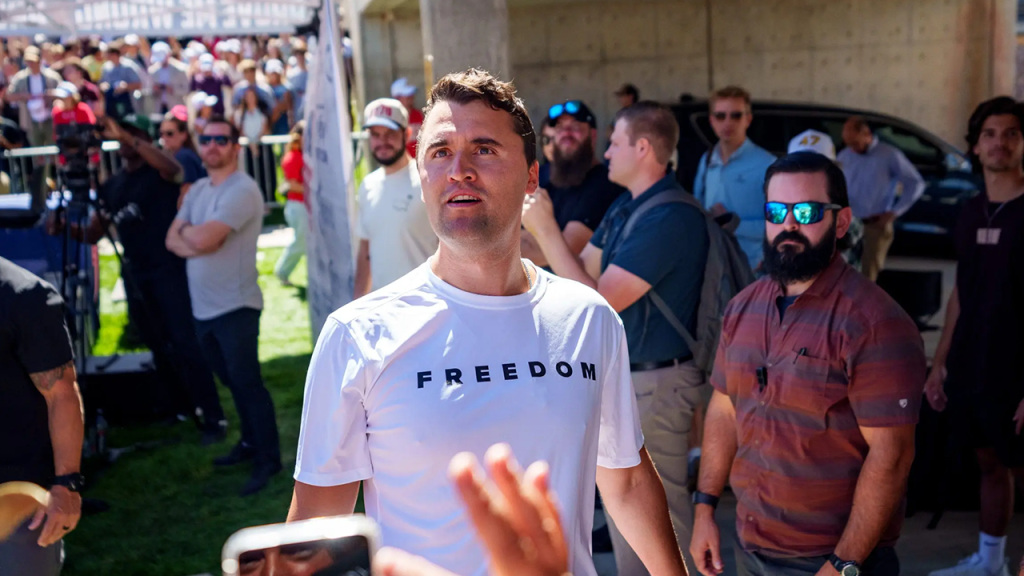The Tragic Assassination of Charlie Kirk: Questions of Security and Responsibility
In a somber revelation two weeks after the shocking assassination of Turning Point USA founder Charlie Kirk, spokesman Andrew Kolvet has provided crucial insights into the security arrangements on that fateful day. Speaking on “The Charlie Kirk Show,” Kolvet clarified a critical detail that has puzzled many since the September 10 tragedy: who had jurisdiction over the rooftop where 22-year-old Tyler Robinson allegedly positioned himself to shoot Kirk. The explanation offers a sobering glimpse into the security limitations that may have contributed to the death of the 31-year-old father of two, who was struck down while speaking at Utah Valley University.
According to Kolvet, Turning Point USA’s security team operated under strict jurisdictional constraints that significantly limited their ability to protect Kirk from distant threats. “In defense of our security team, people need to understand that they do not have jurisdiction on the rooftops or the surrounding area,” Kolvet explained during the broadcast. “Their only jurisdiction on a campus is Charlie’s physical proximity, and they were coordinating with local PD and campus PD to make sure all of those venues [were secure].” This revelation highlights a critical vulnerability in the security apparatus surrounding public figures who lack government protection details. Blake Neff, producer of the show, further emphasized this point by noting that Turning Point USA did not have counter snipers or Secret Service resources to monitor areas beyond Kirk’s immediate vicinity – the kind of comprehensive protection afforded to government officials.
The discussion also brought attention to technological gaps in campus security protocols that might have prevented the tragedy. Kolvet specifically pointed to the absence of drone surveillance programs at many campus police departments as “a big problem” – one he is now actively working to address. “I’m actually working on that because it’s something they should all have. It should be mandated by some sort of law,” he stated, underlining how drones could provide critical aerial monitoring of potential threats. Such technology has increasingly become an essential tool for law enforcement to monitor crowd movements, traffic flow, and security threats in real-time, offering a more cost-effective and rapidly deployable alternative to helicopters. However, even this solution comes with complexities, as police must navigate Federal Aviation Administration regulations and may require special waivers to operate in crowded environments or sensitive locations.
What makes this tragedy particularly poignant is the revelation that Kirk himself had been mindful of security threats, though he apparently hadn’t flagged the Utah Valley University event as particularly high-risk. Dr. James Orr, who appeared on the show, shared a haunting conversation he had with Kirk about an upcoming appearance at the University of Missouri scheduled for September 29. According to Orr, Kirk had specifically identified that event as potentially dangerous, saying, “That’s going to be the tough one. That’s where it’s riskiest. That’s the one that’s going to be the most dangerous.” When Orr expressed concern about security arrangements, Kirk had reassured him, “Yeah, it’s all sorted. Don’t worry about it.” The cruel irony that Kirk was killed at an event he hadn’t specifically identified as high-risk underscores the unpredictable nature of such threats.
The assassination has prompted intense scrutiny of security measures at campus events featuring controversial public figures. The tragedy exposes a troubling gap in protection protocols – while Kirk’s security team was responsible for his immediate safety, the broader perimeter security fell to local and campus police, creating a potential disconnect in comprehensive threat assessment and response. This division of responsibilities raises serious questions about how effectively these different security entities communicate and coordinate, especially when protecting individuals who, while not government officials, nevertheless face significant public hostility due to their political positions. In the aftermath, many are questioning whether current security paradigms are sufficient for the increasingly polarized political climate in which public intellectuals and commentators operate.
As the investigation continues and communities mourn this shocking act of violence, Kirk’s assassination serves as a stark reminder of the very real dangers faced by political figures across the spectrum. Beyond the immediate tragedy of a young father’s life cut short, the incident has catalyzed important conversations about security protocols, jurisdictional responsibilities, and technological solutions that might prevent similar attacks in the future. For Turning Point USA and other organizations that regularly coordinate campus speaking engagements, Kirk’s death represents not just a personal loss but a call to reevaluate and potentially revolutionize how security is conceptualized and implemented in environments where multiple agencies share responsibility for public safety. As Kolvet’s comments suggest, meaningful reform may require not just organizational changes but legislative action to ensure comprehensive protection for those whose ideas – however controversial – should never make them targets for violence.


